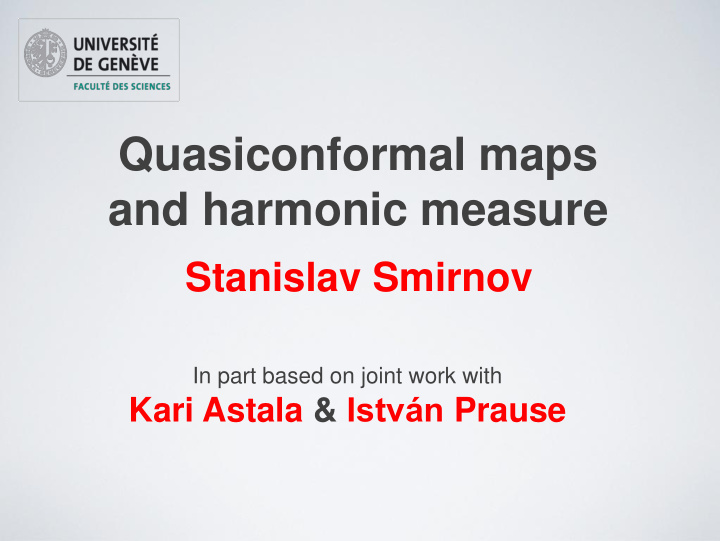



Quasiconformal maps and harmonic measure Stanislav Smirnov In part based on joint work with Kari Astala & István Prause
quasiconformal maps Def 1 eccentricity Def 2 measurable Riemann mapping theorem: (unique up to Möbius ) solution exists depends analytically on
distortion of dimension Theorem [Astala 1994] for k – quasiconformal Rem result is sharp (easy from the proof) In particular, dim E=1 1- k dim (E) 1+ k [Becker-Pommerenke 1987] dim ( ) 1+37 k 2 Conjecture [Astala] dim ( ) 1+ k 2
dimension of quasicircles dim ( ) 1+ k 2 Thm [S] Dual statement: symmetric wrt , } spt dim = 1 dim ( ) 1- k 2 Sharpness??? a nonrectifiable quasicircle
Proof: holomorphic motion Any k - qc map k can be embedded into a holomorphic motion of qc maps , : Define Beltrami coefficient , 1 which is | |-qc Mañé -Sad-Sullivan, Slodkowski : A holomorphic motion of a set can be extended to a holomorpic motion of qc maps
Proof: fractal approximation (E ) E a packing of disks evolves in the motion {B } “complex radii” {r } C (E ) Cantor sets
Proof: “thermodynamics” P(t) Pressure [Ruelle, Bowen] 1 P (t) := log( |r j ( )| t ) I p dim C “Entropy” I p := p j log (1/p j ) 0 t I p / p “ Lyapunov exponent” p ( ) := p j log (1/|r j ( )|) ( harmonic in !) Variational principle (Jensen’s inequality) P (t) = sup p j log (|r j ( )| t /p j ) = sup (I p – t p ( )) p Prob p Prob Bowen’s formula: dim C = root of P = sup I p / p ( ) p Prob
Proof: Harnack’s inequality • dim C 0 1 I p / p (0) 1 p (0) I p /2 I p /2 • dim C 2 I p / p ( ) 2 p ( ) I p /2 0 • Harnack p ( ) p ( ) dim C sup p I p / p ( ) 1 + | | • Quasicircle (anti)symmetric motion even “quadratic” Harnack dim C 1 + | | 2
Proof: symmetrization Thm [S] the following are equivalent: = ( ) and is k -qc a. = ( ) and is qc in + and conformal in – b. = ( ) and is k -qc and antisymmetric c. symmetric: antisymmetric:
harmonic measure • Brownian motion exit probability • conformal map image of the length • potential theory equilibrium measure • Dirichlet problem for
multifractality of “fjords and spikes” scaling: geometric Meaning : Beurling’s theorem: spectrum: Courtesy of D. Marshall Makarov’s theorem: Borel dim , f ( )
Many open problems reduce to estimating the universal spectrum f(α) over all simply connected domains α Conjecture : [Brennan-Carleson-Jones- Krätzer -Makarov]
Legendre transform & pressure Restrict pressure to conformal maps : + (t) := log( |r j ( )| t ) Universal pressure (t) := sup (t) Thm [Makarov 1998] Legendre transforms: f ( ) = inf t { (t)+t} (t) = sup {( f ( )-t)/ } Conjecture: (t) = (2-t) 2 /4 (t) 1 t 0 2
finding the universal spectrum no real intuition some numerical evidence only weak estimates Example: (1) gives optimal - coefficient decay rate for bounded conformal maps - growth rate for the length of Green’s lines Conjecturally (1) = 0.25 , best known estimates: 0.23 (1) 0.46 [Beliaev, Smirnov] [Hedenmalm, Shimorin]
fine structure of harmonic measure via the holomorphic motions I. qc deformations of conformal structure and harmonic measure II. motions in bi-disk III. welding conformal structures and Laplacian on 3-manifolds joint work with Kari Astala and István Prause
I. deforming conf structure Recall: spt & dim = 1 dim ( ) 1- k 2 Thm assume that the statement above is sharp: dim = 1 - k 2 k - qc s.t. (dx)= spt then the universal spectrum conjecture holds Rem in general no sharpness (e.g. any porous ), but we need it only for relevant “Gibbs” measures Question: how to deform? (use ?)
I. proof: deforming to For “Gibbs” measures the (t) blue line is tangent to (t) dim Set 1- k 2 := dim and 1 take holomorphic motion such that k (dx)= 0 2 t By Makarov’s theorem dim ( ) dim ( k -1 ( )) = dim (dx) = 1 By Astala’s theorem dim ( ) 1+ k (t) (2-t) 2 /4 measure ( ) measure
II. two-sided spectrum rotation [Binder] two-sided spectrum Beurling’s estimate
II. bidisk motion Take Beltrami in + of norm 1 , symmetrize it ( z ) in + { , = _ ( z ) in – , _ _ _ symmetric for , antisymmetric for -
II. thermodynamics entropy (complex) Lyapunov exponent
II. “easy” estimates • reflection symmetry • diagonal • projections
II. scaling relations (t) 1 0 2 t
II. Beurling and Brennan Beurling is subharmonic Corollary: Brennan’s conjecture: Equivalent question: ? Two-sided: ?
II. two-sided spectrum Conjecture: or Rem it is equivalent to
II. the question We know that and subharmonic p lus more… What do we need to deduce the conjecture?
III. conformal welding two perturbations of conformal structure _ quasisymmetric welding quasicircle
III. welding and dimensions Take three images of the linear measure dx : dim=D dim=D dim=D Then the conjectures before are equivalent to (1-D) 2 (1-D ) (1-D )
III. Questions about (1-D) 2 (1-D ) (1-D ) Rem1 The inequality holds if D = 1. Q1 Can one interpolate to prove it in general? Rem2 For quasicirles arising in quasi-Fuchsian groups the base eigenvalue 0 of the Laplacian on the associated 3-manifold has 1- 0 =(1-D) 2 for Patterson-Sullivan measure Q2 Can one use 3D geometry ?
Recommend
More recommend